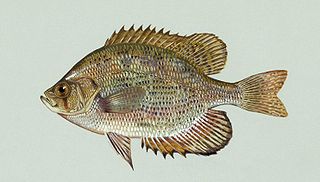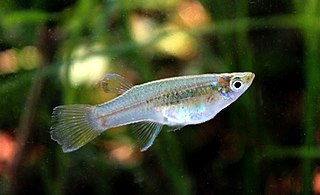The Percopsiformes are a small order of ray-finned fishes, comprising the trout-perch and its allies. It contains just ten extant species, grouped into seven genera and three families. Five of these genera are monotypic

The Poeciliidae are a family of freshwater fishes of the order Cyprinodontiformes, the tooth-carps, and include well-known live-bearing aquarium fish, such as the guppy, molly, platy, and swordtail. The original distribution of the family was the Southeastern United States to north of Río de la Plata, Argentina, and Africa, including Madagascar. Due to release of aquarium specimens and the widespread use of species of the genera Poecilia and Gambusia for mosquito control, though, poeciliids can today be found in all tropical and subtropical areas of the world. In addition, Poecilia and Gambusia specimens have been identified in hot springs pools as far north as Banff, Alberta.

Centrarchidae are a family of freshwater ray-finned fish belonging to the order Perciformes. The type genus is Centrarchus. The centrarchid family comprises 38 species of fish, 34 of which are extant and includes many fish familiar to North Americans, including the rock bass, largemouth bass, bluegill, pumpkinseed, green sunfish, and crappies. All species in the family are native to only North America.

The western mosquitofish is a species of freshwater fish, also known commonly, if ambiguously, as simply mosquitofish or by its generic name, Gambusia, or by the common name gambezi. Its sister species, the eastern mosquitofish,, is also referred to by these names.

Gambusia is a large genus of viviparous fish in the family Poeciliidae. Gambusia contains over 40 species, most of which are principally found in freshwater habitats, though some species may also be found in brackish or saltwater habitats. The type species is the Cuban gambusia, G. punctata. The greatest species richness is in Mexico, Texas, and the Greater Antilles, but species are also found elsewhere in the eastern and southern United States, the Bahamas, Central America, and Colombia. Gambusia species are often called topminnows, or simply gambusias; they are also known as mosquitofish, which, however, refers more specifically to two species, G. affinis and G. holbrooki, which are often introduced into ponds to eat mosquito larvae. As a consequence, they have been introduced widely outside their native range, and frequently become invasive, threatening local species. They are only occasionally kept in aquariums, due to their relative lack of color and the highly aggressive nature of the aforementioned mosquitofish species.

The Cuban gambusia is a species of freshwater fish. It is a member of the family Poeciliidae of order Cyprinodontiformes, and is the type species of its genus. It is native to Cuba, inhabiting primarily stagnant lakes or ponds and slow-moving streams. A carnivorous surface feeder, it occurs in shoals near the shoreline.

Charles Tate Regan FRS was a British ichthyologist, working mainly around the beginning of the 20th century. He did extensive work on fish classification schemes.

The rainbowfish are a family, Melanotaeniidae, of small, colourful, freshwater fish found in northern and eastern Australia, New Guinea, islands in Cenderawasih Bay and Raja Ampat Islands in Indonesia, and in Madagascar.

The eastern mosquitofish is a species of freshwater fish, closely related to the western mosquitofish, Gambusia affinis. It is a member of the family Poeciliidae of order Cyprinodontiformes. The eastern mosquitofish is native to the eastern and southern United States from Florida to Pennsylvania and inland to Alabama and Tennessee, while the western mosquitofish has a larger distribution throughout the United States.
The Clear Creek gambusia is a species of fish in the family Poeciliidae endemic to the United States, particularly Menard County, Texas.
The red-finned blue-eye is a tiny, critically endangered species of fish in the Pseudomugilidae family and the only species in its genus. The species was first recorded in 1990. It is endemic to central Queensland in Australia, where it is restricted to springs in Bush Heritage's Edgbaston Reserve.

The eastern mosquitofish was introduced to Australia in 1925, and has since spread from the northeast coasts to New South Wales, southern Australia, and parts of Western Australia by 1934. Currently, known populations of wild mosquitofish occur in every state and territory except the Northern Territory, and are found in swamps, lakes, billabongs, thermal springs, salt lakes, and ornamental ponds. Mosquitofish are considered a noxious pest, especially in New South Wales and Queensland, and it is illegal to release them into the wild or transport them live into any of the states or territories. Mosquitofish were introduced by military and local councils to control mosquito populations, however there has been no evidence that Gambusia has had any effect in controlling mosquito populations or mosquito-borne diseases. In fact, studies have shown that Gambusia can suffer mortalities if fed only on mosquito larvae, and survivors show poor growth and maturation. Gambusia typically eat zooplankton, beetles, mayflies, caddis flies, mites and other invertebrates; mosquito larvae make up only a small portion of their diet. Gambusia are eaten by juvenile cod.

The ornate rainbowfish is a species of rainbowfish endemic to an area in eastern Australia, where it is native to coastal regions and sandy offshore islands in southern Queensland and northern New South Wales. It is the only known member of its genus. It is a popular aquarium fish.

Brachyrhaphis is a genus of poeciliids native to freshwater habitats in Central America. Most are restricted to Panama and Costa Rica, but B. holdridgei also occurs in Nicaragua and B. hartwegi is from Mexico and Guatemala. A recent phylogenetic analysis has suggested that Brachyrhaphis may not be of a monophyletic group.

Heterophallus is a genus of small poeciliids found near the coast in calm waters of river basins in southeastern Mexico.
Gambusia quadruncus, known as the llanos mosquitofish, is a species of bony fish in the genus Gambusia, part of the family Poeciliidae, that lives in east-central Mexico. Sometimes coexisting with at least three similar species, it differs from its closest relative, Gambusia affinis, in several characteristics with plausible effects on reproductive isolation.
"Combined analysis of mitochondrial and nuclear gene sequence data indicates reciprocal monophyly of the species and its sister species Gambusia affinis, with levels of genetic divergence suggesting the two species diverged from one another over a million years ago. The origin of Gambusia quadruncus may reflect a vicariant event associated with Pliocene orogenesis in the Tamaulipas Arch and a frontal section of the Sierra Madre Oriental ."
Priapichthys annectens is a species of freshwater fish. It is a member of the family Poeciliidae of order Cyprinodontiformes. It is the type species of the genus Priapichthys. It is native to Costa Rica, primarily inhabiting brooks and streams with currents of low to high velocity. A carnivorous surface feeder, it occurs in shoals near the shoreline.

Poeciliinae is a subfamily of killifish from the family Poeciliidae which contains species from the Americas which are collectively known as the livebearers because many, but not all, of the species within the subfamily are ovoviviparous.

Melanotaeniinae the Australian rainbowfishes is a subfamily of the rainbowfishes of the family Melanotaeniidae. They are a group of small, colourful, freshwater fish found in northern and eastern Australia, New Guinea, islands in Cenderawasih Bay the Raja Ampat Islands in Indonesia and in Madagascar.













